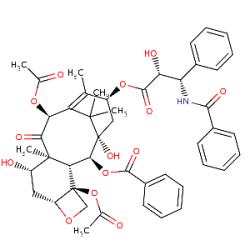Rohan Patil/Sandbox1
From Proteopedia
| Line 1: | Line 1: | ||
| + | [[Image:taxol.png|frame|Paclitaxel (Taxol)]] | ||
| + | |||
A [[CBI Molecule]] being studied in the [http://www.umass.edu/cbi/ University of Massachusetts Amherst Chemistry-Biology Interface Program] at UMass Amherst and on display at the [http://www.molecularplayground.org/ Molecular Playground]. | A [[CBI Molecule]] being studied in the [http://www.umass.edu/cbi/ University of Massachusetts Amherst Chemistry-Biology Interface Program] at UMass Amherst and on display at the [http://www.molecularplayground.org/ Molecular Playground]. | ||
| - | + | Paclitaxel, also called as Taxol, is a plant derived anticancer drug. It was first isolated from the bark of Pacific yew tree, Taxus brevifolia. It has been FDA approved for the treatment of ovarian, breast and non-small cell lung cancer. Taxol binds to the ends of microtubules and inhibits further microtubule elongation. This prevents the cell from dividing and causes the cell to die. Because cancer cells divide much quicker than normal cells, taxol predominantly attacks tumors. | |
| + | Presently, taxol supply is made available either through a semi-synthetic route using precursors isolated from needles of yew species or through Taxus cell suspension cultures. Taxus cell suspension culture is an alternative to stripping bark from Taxus trees and extracting precursors from needles. | ||
| - | A bacterial chemotaxis receptor is an unusually long alpha-helical structure. The attractant molecule (the ligand) binds near the top of this picture and sends a signal across the membrane into the cell to control proteins that bind near the bottom. This is a model of the structure of the receptor based on experimental structures of pieces of related proteins. | ||
Revision as of 18:01, 28 April 2010
A CBI Molecule being studied in the University of Massachusetts Amherst Chemistry-Biology Interface Program at UMass Amherst and on display at the Molecular Playground.
Paclitaxel, also called as Taxol, is a plant derived anticancer drug. It was first isolated from the bark of Pacific yew tree, Taxus brevifolia. It has been FDA approved for the treatment of ovarian, breast and non-small cell lung cancer. Taxol binds to the ends of microtubules and inhibits further microtubule elongation. This prevents the cell from dividing and causes the cell to die. Because cancer cells divide much quicker than normal cells, taxol predominantly attacks tumors.
Presently, taxol supply is made available either through a semi-synthetic route using precursors isolated from needles of yew species or through Taxus cell suspension cultures. Taxus cell suspension culture is an alternative to stripping bark from Taxus trees and extracting precursors from needles.
|

